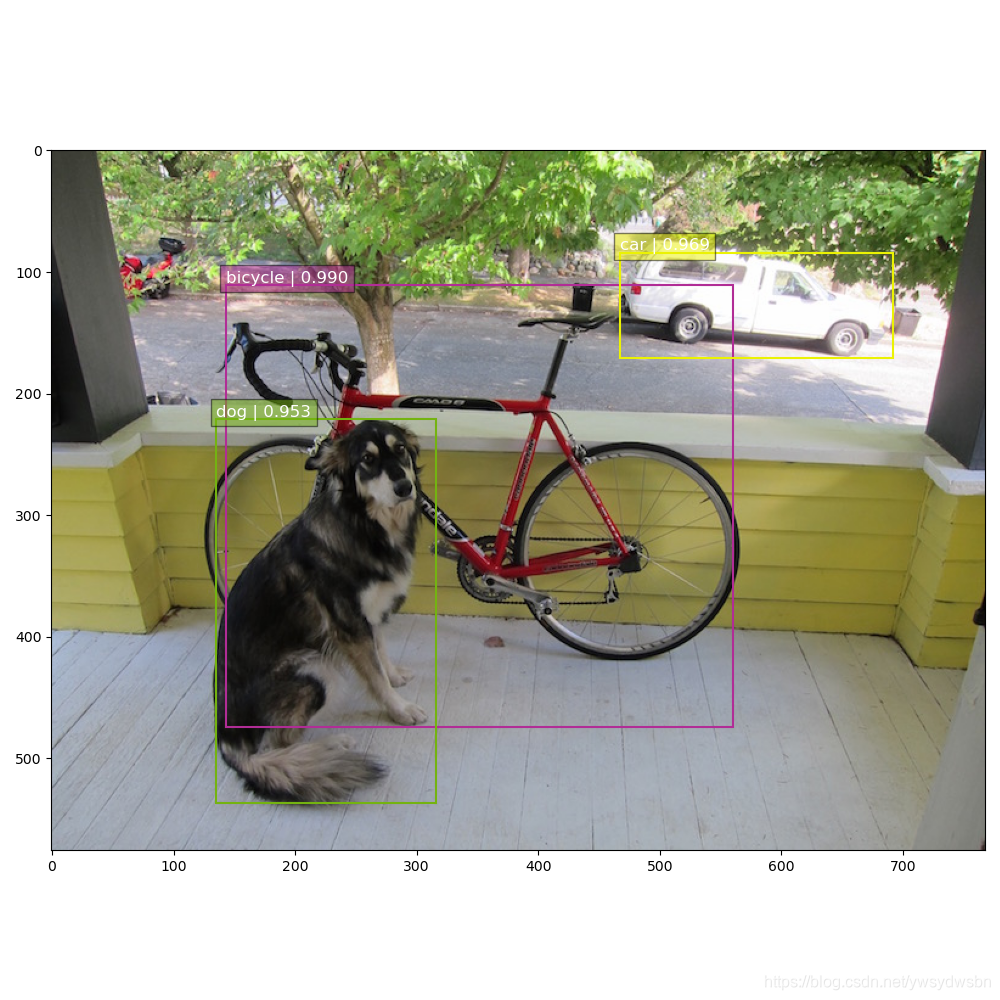在利用SSD_Tensorflow进行目标检测时,检测出来的结果的显示框上往往都显示的是数字,如下图所示。

这样检测出来的结果不是很直观。我们最想要的结果应该是在显示框上可以明确显示物体的分类情况。如下图所示:

因此我们需要对SSD-Tensorflow/notebooks/visualization.py进行相应的修改。
修改结果如下:visualization.py
需要修改的地方我都用#================================进行了标注,大家可以对照的看一下。
# Copyright 2017 Paul Balanca. All Rights Reserved.
#
# Licensed under the Apache License, Version 2.0 (the "License");
# you may not use this file except in compliance with the License.
# You may obtain a copy of the License at
#
# http://www.apache.org/licenses/LICENSE-2.0
#
# Unless required by applicable law or agreed to in writing, software
# distributed under the License is distributed on an "AS IS" BASIS,
# WITHOUT WARRANTIES OR CONDITIONS OF ANY KIND, either express or implied.
# See the License for the specific language governing permissions and
# limitations under the License.
# ==============================================================================
import cv2,sys
import random
import matplotlib.pyplot as plt
import matplotlib.image as mpimg
import matplotlib.cm as mpcm
# =========================================================================== #
# Some colormaps.
# =========================================================================== #
def colors_subselect(colors, num_classes=21):
dt = len(colors) // num_classes
sub_colors = []
for i in range(num_classes):
color = colors[i*dt]
if isinstance(color[0], float):
sub_colors.append([int(c * 255) for c in color])
else:
sub_colors.append([c for c in color])
return sub_colors
colors_plasma = colors_subselect(mpcm.plasma.colors, num_classes=21)
colors_tableau = [(255, 255, 255), (31, 119, 180), (174, 199, 232), (255, 127, 14), (255, 187, 120),
(44, 160, 44), (152, 223, 138), (214, 39, 40), (255, 152, 150),
(148, 103, 189), (197, 176, 213), (140, 86, 75), (196, 156, 148),
(227, 119, 194), (247, 182, 210), (127, 127, 127), (199, 199, 199),
(188, 189, 34), (219, 219, 141), (23, 190, 207), (158, 218, 229)]
# =========================================================================== #
# OpenCV drawing.
# =========================================================================== #
def draw_lines(img, lines, color=[255, 0, 0], thickness=2):
"""Draw a collection of lines on an image.
"""
for line in lines:
for x1, y1, x2, y2 in line:
cv2.line(img, (x1, y1), (x2, y2), color, thickness)
def draw_rectangle(img, p1, p2, color=[255, 0, 0], thickness=2):
cv2.rectangle(img, p1[::-1], p2[::-1], color, thickness)
def draw_bbox(img, bbox, shape, label, color=[255, 0, 0], thickness=2):
p1 = (int(bbox[0] * shape[0]), int(bbox[1] * shape[1]))
p2 = (int(bbox[2] * shape[0]), int(bbox[3] * shape[1]))
cv2.rectangle(img, p1[::-1], p2[::-1], color, thickness)
p1 = (p1[0]+15, p1[1])
cv2.putText(img, str(label), p1[::-1], cv2.FONT_HERSHEY_DUPLEX, 0.5, color, 1)
def bboxes_draw_on_img(img, classes, scores, bboxes, colors, thickness=2):
shape = img.shape
for i in range(bboxes.shape[0]):
bbox = bboxes[i]
color = colors[classes[i]]
# Draw bounding box...
p1 = (int(bbox[0] * shape[0]), int(bbox[1] * shape[1]))
p2 = (int(bbox[2] * shape[0]), int(bbox[3] * shape[1]))
cv2.rectangle(img, p1[::-1], p2[::-1], color, thickness)
# Draw text...
s = '%s/%.3f' % (classes[i], scores[i])
p1 = (p1[0]-5, p1[1])
cv2.putText(img, s, p1[::-1], cv2.FONT_HERSHEY_DUPLEX, 0.4, color, 1)
# =========================================================================== #
# Matplotlib show...
# =========================================================================== #
def plt_bboxes(img, classes, scores, bboxes, figsize=(10,10), linewidth=1.5):
"""Visualize bounding boxes. Largely inspired by SSD-MXNET!
"""
# =========================================
def num2class(n):
sys.path.append('../')
from datasets import pascalvoc_2007 as pas
x = pas.pascalvoc_common.VOC_LABELS.items()
for name, item in x:
if n in item:
return name
# =========================================
fig = plt.figure(figsize=figsize)
plt.imshow(img)
height = img.shape[0]
width = img.shape[1]
colors = dict()
class_names = [] # 用来储存类别名(一张图有可能不只一个类别名)
for i in range(classes.shape[0]):
cls_id = int(classes[i])
if cls_id >= 0:
score = scores[i]
if cls_id not in colors:
colors[cls_id] = (random.random(), random.random(), random.random())
ymin = int(bboxes[i, 0] * height)
xmin = int(bboxes[i, 1] * width)
ymax = int(bboxes[i, 2] * height)
xmax = int(bboxes[i, 3] * width)
rect = plt.Rectangle((xmin, ymin), xmax - xmin,
ymax - ymin, fill=False,
edgecolor=colors[cls_id],
linewidth=linewidth)
plt.gca().add_patch(rect)
# class_name = str(cls_id)
# ==================================
class_name = num2class(cls_id)
class_names.append(class_name)
# ==================================
plt.gca().text(xmin, ymin - 2,
'{:s} | {:.3f}'.format(class_name, score),
bbox=dict(facecolor=colors[cls_id], alpha=0.5),
fontsize=12, color='white')
plt.show()
# ==================================
return class_names
# ==================================
进行测试;
# 测试图片:
from notebooks import visualization
from preprocessing import ssd_vgg_preprocessing
from nets import ssd_vgg_300, ssd_common, np_methods
import matplotlib.image as mpimg
import matplotlib.pyplot as plt
import os
import math
import random
import numpy as np
import tensorflow as tf
import cv2
slim = tf.contrib.slim
gpu_options = tf.GPUOptions(allow_growth=True)
config = tf.ConfigProto(log_device_placement=False, gpu_options=gpu_options)
isess = tf.InteractiveSession(config=config)
net_shape = (300, 300)
data_format = 'NHWC'
# DATA_FORMAT = 'NCHW' # gpu
# DATA_FORMAT = 'NHWC' # cpu
img_input = tf.placeholder(tf.uint8, shape=(None, None, 3))
image_pre, labels_pre, bboxes_pre, bbox_img = ssd_vgg_preprocessing.preprocess_for_eval(
img_input, None, None, net_shape, data_format, resize=ssd_vgg_preprocessing.Resize.WARP_RESIZE)
image_4d = tf.expand_dims(image_pre, 0)
reuse = True if 'ssd_net' in locals() else None
ssd_net = ssd_vgg_300.SSDNet()
with slim.arg_scope(ssd_net.arg_scope(data_format=data_format)):
predictions, localisations, _, _ = ssd_net.net(
image_4d, is_training=False, reuse=reuse)
ckpt_filename = './checkpoints/ssd_300_vgg.ckpt'
isess.run(tf.global_variables_initializer())
saver = tf.train.Saver()
saver.restore(isess, ckpt_filename)
ssd_anchors = ssd_net.anchors(net_shape)
def process_image(img, select_threshold=0.5, nms_threshold=.45, net_shape=(300, 300)):
rimg, rpredictions, rlocalisations, rbbox_img = isess.run([image_4d, predictions, localisations, bbox_img],
feed_dict={img_input: img})
rclasses, rscores, rbboxes = np_methods.ssd_bboxes_select(
rpredictions, rlocalisations, ssd_anchors,
select_threshold=select_threshold, img_shape=net_shape, num_classes=21, decode=True)
rbboxes = np_methods.bboxes_clip(rbbox_img, rbboxes)
rclasses, rscores, rbboxes = np_methods.bboxes_sort(
rclasses, rscores, rbboxes, top_k=400)
rclasses, rscores, rbboxes = np_methods.bboxes_nms(
rclasses, rscores, rbboxes, nms_threshold=nms_threshold)
rbboxes = np_methods.bboxes_resize(rbbox_img, rbboxes)
return rclasses, rscores, rbboxes
image_path = './demo/dog.jpg' # 图片路径
img = mpimg.imread(image_path)
rclasses, rscores, rbboxes = process_image(img) # 这里传入图片
# labeled_img = visualization.bboxes_draw_on_img(
# img, rclasses, rscores, rbboxes, visualization.colors_plasma) # 返回标注图片
visualization.plt_bboxes(img, rclasses, rscores, rbboxes) # 展示(plt)标注图片
显示框明确显示物体的分类:

